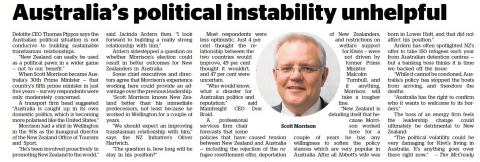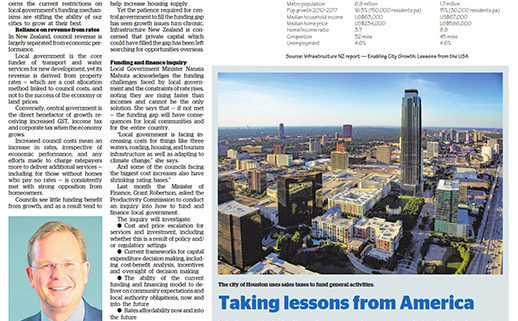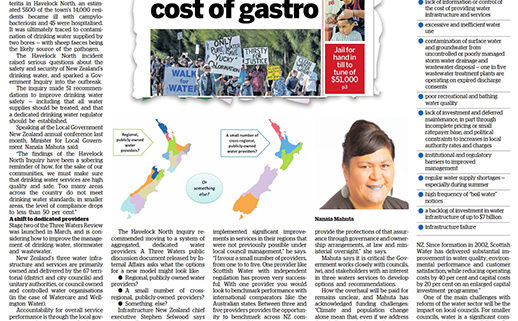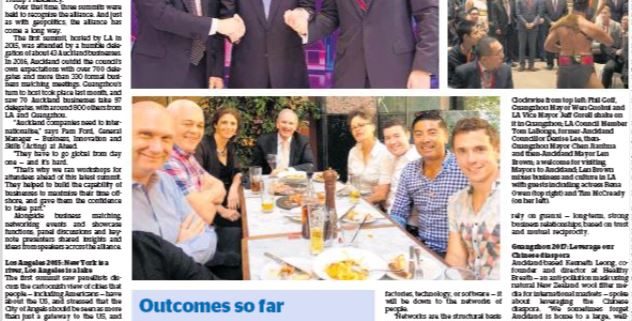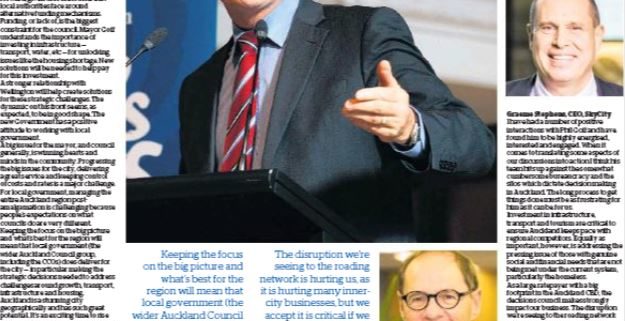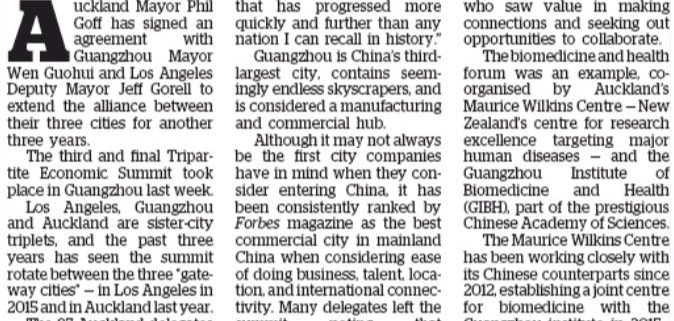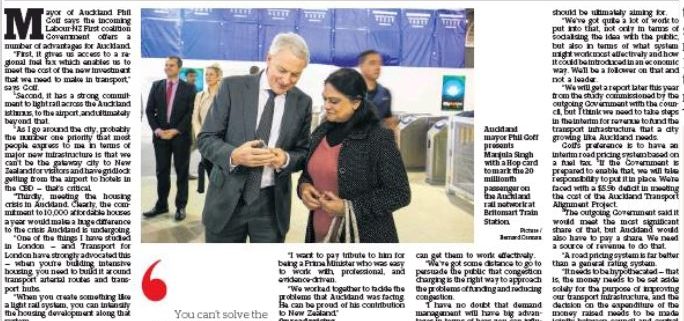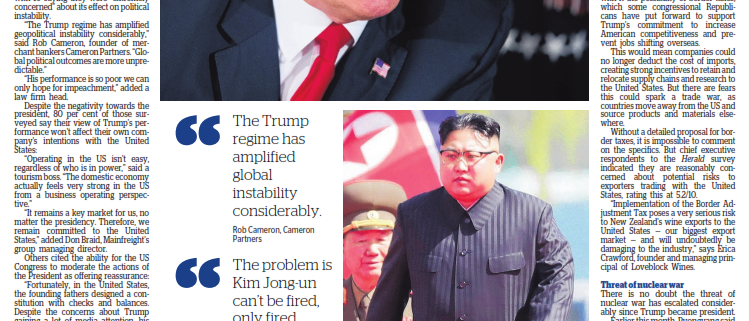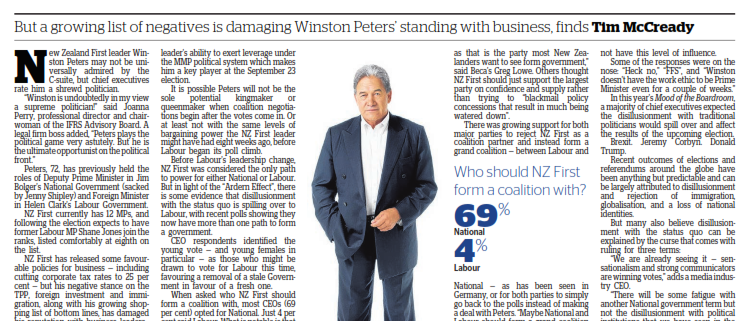Infrastructure: Local funding for growth (NZ Herald)
Are restrictions on local government funding mechanisms stifling the ability of our cities to grow at their best?
When running for mayoralty in 2016, Phil Goff made the following commitment on rates:
“Rate rises will be kept low and affordable at an average of 2.5 per cent per annum or less, if current council fiscal projections are correct and the consumer price index stays low.”
The question of how much rates will rise — and the commitment to keep them as low as possible — are cornerstones of any recent Auckland mayoral bid. But there are concerns the current restrictions on local government’s funding mechanisms are stifling the ability of our cities to grow at their best.
Reliance on revenue from rates
In New Zealand, council revenue is largely separated from economic performance.
Local government is the core funder of transport and water services for new development, yet its revenue is derived from property rates — which are a cost allocation method linked to council costs, and not to the success of the economy or land prices.
Conversely, central government is the direct benefactor of growth: receiving increased GST, income tax and corporate tax when the economy grows.
Increased council costs mean an increase in rates, irrespective of economic performance, and any efforts made to charge ratepayers more to deliver additional services — including for those without homes who pay no rates — is consistently met with strong opposition from homeowners.
Councils see little funding benefit from growth, and as a result tend to have a culture of cost minimisation, heavily influencing their decision making at the expense of value creation.
“Importantly, from a local government economic development perspective, property taxes are not the best incentive to encourage councils to invest in infrastructure,” says Local Government Funding Agency chair Craig Stobo.
“If council revenue streams were tied to their performance, successful councils would accrue more revenue, providing more choices for their communities.”
This is not a new concern: a 2015 review into local government funding by Local Government New Zealand (LGNZ) found that the heavy reliance on property taxes to fund local services and infrastructure fails to incentivise councils to invest for growth.
The only other major source of revenue local government currently has in its toolkit is to lobby central government: Shane Jones’ Provincial Growth Fund will see an investment boost in regional New Zealand, and the Housing Infrastructure Fund is aiding high growth councils to advance infrastructure projects that will help increase housing supply.
Yet the patience required for central government to fill the funding gap has seen growth issues turn chronic. Infrastructure New Zealand is concerned that private capital which could have filled the gap has been left searching for opportunities overseas.
Funding and finance inquiry
Local Government Minister Nanaia Mahuta acknowledges the funding challenges faced by local government and the constraints of rate rises, noting they are rising faster than incomes and cannot be the only solution. She says that — if not met — the funding gap will have consequences for local communities and for the entire country.
“Local government is facing increasing costs for things like three waters, roading, housing, and tourism infrastructure as well as adapting to climate change,” she says.
And some of the councils facing the biggest cost increases also have shrinking rating bases.”
Last month the Minister of Finance, Grant Robertson, asked the Productivity Commission to conduct an inquiry into how to fund and finance local government.
The inquiry will investigate:
- Cost and price escalation for services and investment, including whether this is a result of policy and/or regulatory settings
- Current frameworks for capital expenditure decision making, including cost-benefit analysis, incentives and oversight of decision making
- The ability of the current funding and financing model to deliver on community expectations and local authority obligations, now and into the future
- Rates affordability now and into the future
- Options for new funding and financing tools to serve demand for investment and service
- Constitutional and regulatory issues that may underpin new project financing entities with broader funding powers, and
- Whether changes are needed to regulatory arrangements overseeing local authority funding and financing.
Stobo says the terms of reference given to the Commission by Robertson are very good, and the requirement to consult with the sector is a helpful recognition of the expertise the sector can bring to the table.
“Prospectively this could lead to some devolution of tax setting and collection powers to local government, and a cessation of inefficient quota handouts from central government.
“The final results need to improve the incentives for councils to responsibly invest in local growth,” he says.
The New Zealand Initiative’s executive director, Dr Oliver Hartwich, is confident the Productivity Commission will produce good results.
“What is important for the Productivity Commission’s inquiry is to consider the incentives under which local government operates, and the Terms of Reference certainly allow that,” he says. “More specifically, it will allow the commission to consider the OECD’s recommendation to the New Zealand government that councils should participate in tax revenue increases resulting from economic growth.”
The commission’s final report is expected to be presented by November 2019.
Calling for localism
Coinciding with the announcement of an inquiry, LGNZ and The New Zealand Initiative launched their Localism project, calling for a shift in the way public decisions are made in New Zealand by seeking a commitment to localism. LGNZ President and Dunedin Mayor David Cull says it is important the new funding options incentivise growth.
“[The Localism Project] will highlight how the right incentives and funding can build strong local economies and vibrant communities. The urgent need to properly empower councils is reinforced by the fact that decentralised countries tend to have higher levels of prosperity than centralised ones.
“New Zealand is among the most centralised countries in the world.
“We should not expect central government in Wellington to be the best decision-maker for every local problem. Communities often know best what they need.”
The New Zealand Initiative’s Hartwich adds: “After more than a century of centralism, New Zealand needs to go local.
“Councils and communities must be able to make their own decisions about their future.”
A final report and publication of the Localism Proposal is expected in early 2020, and Hartwich notes there will be ample opportunity for the Localism report and the Productivity Commission inquiry to cross-fertilise.
Taking lessons from America
The city of Houston uses sales taxes to fund general activities.
Earlier this year, Infrastructure New Zealand led a delegation of NZ representatives to Portland, Denver, Dallas-Fort Worth, and Houston — four US cities that are growing more affordably than Auckland — to consider how they are doing what they are doing, and what New Zealand can learn from them.
The report, Enabling City Growth: Lessons from the USA, provides detail on the lessons learnt from the visit, including the following on how local authorities are funded:
- US cities have a number of funding mechanisms that are tied to their economic performance. Denver, Dallas, and Houston use sales taxes to fund general activities, and each has levied a 1 per cent sales tax to deliver improved public transport.
- Dallas and Houston have property taxes with a strong link to property value. In each case, the revenue of the city and its component institutions increases with the success of the city in growing the economy and delivering homes.
- Portland, the city with the greatest growth challenges, also has the fewest incentives to grow. There is no sales tax in Oregon, removing this option also for Portland.
- Instead, Oregon relies on comparatively high income and corporate taxes, but has not extended the ability for Portland to levy these direct.
- Property taxes in Portland have been tied to inflation since the early 1990s. Thus, property values have now become detached from property rates and the two are only reviewed when properties are significantly changed or redeveloped.
Infrastructure: Proposals that hold water (NZ Herald)
Suggestions for reform could impact on local councils, reports Tim McCready.
Figures released last month in a Ministry of Health report show one in five New Zealanders are drinking water from water supplies that don’t meet current drinking water standards.
The report shows larger suppliers — including Auckland’s Watercare, Wellington Water, and Dunedin — are meeting compliance standards throughout the year. But many smaller communities are failing to comply, including some of New Zealand’s most iconic tourism destinations: Coromandel, Whangamata, Waitomo Caves, Tekapo and Milford Sound.
In the 2016 outbreak of gastroenteritis in Havelock North, an estimated 5500 of the town’s 14,000 residents became ill with campylobacteriosis and 45 were hospitalised. It was ultimately traced to contamination of drinking water supplied by two bores — with sheep faeces being the likely source of the pathogen.
The Havelock North incident raised serious questions about the safety and security of New Zealand’s drinking water, and sparked a Government Inquiry into the outbreak.
The inquiry made 51 recommendations to improve drinking water safety — including that all water supplies should be treated, and that a dedicated drinking water regulator should be established.
Speaking at the Local Government New Zealand annual conference last month, Minister for Local Government Nanaia Mahuta said:
“The findings of the Havelock North Inquiry have been a sobering reminder of how, for the sake of our communities, we must make sure that drinking water services are high quality and safe. Too many areas across the country do not meet drinking water standards; in smaller areas, the level of compliance drops to less than 50 per cent.”
A shift to dedicated providers
Stage two of the Three Waters Review was launched in March, and is considering how to improve the management of drinking water, stormwater and wastewater.
New Zealand’s three water infrastructure and services are primarily owned and delivered by the 67 territorial (district and city councils) and unitary authorities, or council-owned and controlled water organisations (in the case of Watercare and Wellington Water).
Accountability for overall service performance is through the local government election process. In theory, if the public is unhappy with the performance of their council they will elect new councillors. But in reality, most members of the public do not have the information, capability, or desire to effectively monitor service outcomes. In many cases — including Havelock North — it is not until things go wrong that the public find out the extent of the problem.
The Havelock North inquiry recommended moving to a system of aggregated, dedicated water providers. A Three Waters public discussion document released by Internal Affairs asks what the options for a new model might look like:
- Regional, publicly-owned water providers?
- A small number of cross-regional, publicly-owned providers?
- Something else?
Infrastructure New Zealand chief executive Stephen Selwood says scale really matters in the water business, because as well as enabling economies of scale, it provides the revenue base to maximise skills capability and capacity to govern, fund, oversee and operate water service delivery effectively.
“The value of scale and capability is already being clearly demonstrated by Watercare and Wellington Water who have between successfully implemented significant improvements in services in their regions that were not previously possible under local council management,” he says. “I favour a small number of providers, from one to to five. One provider like Scottish Water with independent regulation has proven very successful. With one provider you would look to benchmark performance with international comparators like the Australian states. Between three and five providers provides the opportunity to benchmark across NZ companies as well.”
Mahuta, who recently returned from a research trip to Scotland and Ireland to consider the models used there, says there are no pre-determined solutions, but a bottom line is continued public ownership of existing three waters infrastructure.
“Any option must ensure continued public ownership of existing infrastructure assets and we must provide the protections of that assurance through governance and ownership arrangements, at law and ministerial oversight,” she says.
Mahuta says it is critical the Government works closely with councils, iwi, and stakeholders with an interest in three waters services to develop options and recommendations.
How the overhaul will be paid for remains unclear, and Mahuta has acknowledged funding challenges: “Climate and population change alone mean that, even if we address the challenges in front of us now, significant funding pressures will continue to arise for decades to come.” Selwood says it should pay for itself, citing Scottish Water as an example:
“This publicly-owned national water service provider delivers drinking and wastewater services to five million people across an urban and rural hinterland comparable to NZ.
Since formation in 2002, Scottish Water has delivered substantial improvement in water quality, environmental performance and customer satisfaction, while reducing operating costs by 40 per cent and capital costs by 20 per cent on an enlarged capital investment programme.”
One of the main challenges with reform of the water sector will be the impact on local councils. For smaller councils, water is a significant component of their responsibilities.
Removing these raises questions about future viability.
Says Selwood: “I think this provides an opportunity to refocus councils from managing utilities and engineering challenges to being more focused on their communities, their people and giving true meaning to local engagement and participation by people in local affairs.”
Sector deficiencies
Successive reports over the past two decades undertaken by a diverse range of agencies and organisations (including the Office of the Auditor General, Water New Zealand, Engineering New Zealand, Infrastructure New Zealand, the Parliamentary Commissioner for the Environment and the Local Government Infrastructure Efficiency Expert Advisory Group) have pointed to serious deficiencies across the sector. Between them, these expert bodies have compiled a compelling case for change.
- Major challenges include:
- lack of information about the state of infrastructure assets — especially in small rural councils
- lack of information or control of the cost of providing water infrastructure and services
- excessive and inefficient water use
- contamination of surface water and groundwater from uncontrolled or poorly managed storm water drainage and wastewater disposal — one in five wastewater treatment plants are operating on expired discharge consents
- poor recreational and bathing water quality
- lack of investment and deferred maintenance, in part through incomplete pricing or small ratepayer base, and political constraints to increases in local authority rates and charges
- institutional and regulatory barriers to improved management
- regular water supply shortages — especially during summer
- high frequency of “boil water” notices
- a backlog of investment in water infrastructure of up to $7 billion
- infrastructure failure.
Project Auckland: A view from the summits (NZ Herald)
The Memorandum of Understanding of Economic Alliance between sister city triplets Auckland, Guangzhou and Los Angeles was signed in 2014 – and if a week is a long time in politics, three years certainly is.
Since then, New Zealand has had three prime ministers. Former Auckland mayor Len Brown “The Singing Mayor” hung up his chains – replaced by Phil Goff, known less for his singing abilities and instead for his prowess in forging New Zealand’s free trade agreement with China.
Guangzhou also changed its mayor in 2016, and although Democratic Party superdelegate Eric Garcetti is still mayor of LA, President Obama was replaced by the entirely different Trump Presidency.
Over that time, three summits were held to recognise the alliance. And just as with geopolitics, the alliance has come a long way.
The first summit, hosted by LA in 2015, was attended by a humble delegation of about 43 Auckland businesses.
In 2016, Auckland outdid the council’s own expectations with over 700 delegates and more than 330 formal business matching meetings.
Guangzhou’s turn to host took place last month, and saw 70 Auckland businesses take 97 delegates, with around 800 others from LA and Guangzhou.
“Auckland companies need to internationalise,” says Pam Ford, General Manager – Business, Innovation and Skills (Acting) at Ateed.
“They have to go global from day one – and it’s hard. “That’s why we ran workshops for attendees ahead of this latest summit. They helped to build the capability of businesses to maximise their time offshore, and gave them the confidence to take part.”
Alongside business matching, networking events and showcase functions, panel discussions and keynote presenters shared insights and ideas from speakers across the alliance.
Los Angeles 2015: New York is a river, Los Angeles is a lake
The first summit saw panellists discuss the cartoonish view of cities that people – including Americans – have about the US, and stressed that the City of Angels should be seen as more than just a gateway to the US, and certainly more than just Hollywood.
Hollywood makes up only a fraction of Los Angeles’ economy. As well as tourism, it is the US’ largest manufacturing centre, a hub for aerospace, logistics, clean technology and innovation, and home to the largest port in the Western hemisphere.
It is the country’s fastest growing tech start-up region – many arguing it has benefits over San Francisco or Silicon Valley for a tech launchpad.
Despite this, there is no denying LA remains the creative capital of the US. One in seven people are employed in a creative field, and it is the top American metro area for art, design and media employment, providing more than US$140b (NZ$203b) of annual economic impact to the city.
“One of the things the LA summit did was open people’s minds that it is more than just film,” says Ford.
“LA is the place for many of Auckland’s companies that create content. Content now fits across so many more mediums – from gaming and television to social media and particularly the influencer economy.”
“But LA is also about cleantech, food and beverage, design and manufacturing. “Because of this three-year relationship, we’ve developed solid partnerships with the organisations for our companies to access – whether that is through the World Trade Center Los Angeles or the Los Angeles Business Council – that we would not otherwise have had.”
One panellist – a resident of LA – described how the city unfolds as you spend more time there. “New York is a river, but Los Angeles is a lake. If you step outside in New York you will naturally go somewhere, the city itself will take you and it is simple to navigate.
“In Los Angeles, to get anywhere you have to actively swim there – or you risk never getting anywhere at all. But that’s what makes it so exciting.”
Auckland 2016: Partnerships, People, and Cross-pollination
The Auckland summit saw global heavyweights take to the stage at the Viaduct Events Centre, speaking about the importance of partnerships and collaboration, and the opportunities that arise when you bring people together and ‘cross-pollinate’ ideas.
Sunny Bates, a serial entrepreneur and a founding board member of Kickstarter who has served as an adviser to companies including GE, TED and P&G, insisted the economic driver of the future won’t come from factories, technology, or software – it will be down to the networks of people.
“Networks are the structural basis for globalisation and for modernisation,” says Bates.
“Networks know no boundaries, and cultural networks are extremely powerful.”
Former Nike innovation expert Erez Morag agreed that networks were critical, but said it wasn’t those networks on their own that lead to innovation, but instead the cross-pollination of ideas through those networks.
“Instead of chasing the competition, chase the insights, listen to everyone, and play bigger than your size,” he says.
Morag used jogging as an example of cross pollination. In 1961, Kiwi runner and athletics coach Arthur Lydiard organised the world’s first jogging club in Auckland, promoting the cardiovascular health benefits of easy distance running.
Lydiard introduced Nike co-founder Bill Bowerman to the concept of jogging on a chance visit to New Zealand.
“[Jogging was] invented in New Zealand and commercialised in the United States,” says Morag – all through the cross-pollination of ideas.
Throughout the Auckland Summit, then-Maori Development Minister Te Ururoa Flavell reinforced the importance of trusted partnerships to the Maori economy. “Maori want to hear your heart, not just slick words.
“If there is no connection to your heart, then there can be no deal – because it will be doomed from the start” – a message that resonated strongly with Chinese delegates, who rely on guanxi – long-term, strong business relationships, based on trust and mutual reciprocity.
Guangzhou 2017: Leverage our Chinese diaspora
Auckland-based Kenneth Leong, co-founder and director at Healthy Breath – an anti-pollution mask using natural New Zealand wool filter media for international markets – spoke about leveraging the Chinese diaspora.
“We sometimes forget Auckland is home to a large, well-connected Chinese business community,” he says.
The summit and surrounding events enabled new connections between the business delegates, and deepened existing relationships.
“Cross-cultural partnerships enrich all parties, by bringing people with great ideas together with people who have connections, capital and channels to market,” says Leong.
“There is a need to accelerate integration between the migrant Chinese and mainstream business communities in Auckland. Everyone is keen to do business together, we just need to create more opportunities for interaction and relationship building.”
New Zealand’s connection to Guangzhou goes back a long way – many of the first Chinese immigrants to New Zealand came from the Pearl River Delta region, including Guangzhou.
Now, Guangzhou is China’s third largest city, contains seemingly endless skyscrapers, and is considered a manufacturing and commercial hub.
It has been consistently ranked by Forbes magazine as the best commercial city in mainland China for ease of doing business, talent, location, and international connectivity, and in many cases, could be a more accessible market for New Zealand businesses than the more recognised larger markets of Shanghai and Beijing.
Project Auckland: Running the ruler over Auckland Mayor Phil Goff (NZ Herald)
It’s just over one year since Phil Goff became Mayor of Auckland after a stellar three decades long career in national politics. Tim McCready asked business leaders to rate how Goff is handling the job.
Heather Ash, Partner, Simpson Grierson: Overall the council is making good progress under Phil Goff’s leadership. My sense is he is working well with council officers and has a good structure around him.
In particular, the proposal for a regional fuel tax is a significant step forward, given the restrictions that local authorities face around alternative funding mechanisms.
Funding, or lack of, is the biggest constraint for the council. Mayor Goff understands the importance of investing in infrastructure – transport, water, etc – for unlocking issues like the housing shortage. New solutions will be needed to help pay for this investment.
A stronger relationship with Wellington will help create solutions for these strategic challenges. The dynamic on this front seems, as expected, to be in good shape. The new Government has a positive attitude to working with local government.
A big issue for the mayor, and council generally, is winning hearts and minds in the community. Progressing the big issues for the city, delivering a great service and keeping control of costs and rates is a major challenge.
For local government, managing the entire Auckland region post-amalgamation is challenging because people’s expectations on what councils do are very different.
Keeping the focus on the big picture and what’s best for the region will mean that local government (the wider Auckland Council group, including the CCOs) does deliver for the city – in particular making the strategic decisions needed to address challenges around growth, transport, infrastructure and housing.
Auckland is a stunning city geographically and has such great potential. It’s an exciting time to rise to these challenges as well as plan for the America’s Cup and Apec.
Kim Campbell, CEO, EMA: Auckland city is facing major challenges.
By 2036 its population is predicted to rise by almost 750,000. We’re already lagging behind in infrastructure investment by billions and that will only be exacerbated with the intensification allowed for under the Unitary Plan.
Furthermore, there continues to be a disconnect between where people live and work, both now and in the future, that will only add to current congestion woes.
Therefore, the mayor’s relationship with Wellington has been constructive and he has a functioning council. After all, he has been successful in convincing the new Coalition Government of the need for a regional petrol tax.
While we don’t necessarily see the petrol tax as a solution, we do know that transport is a major issue for businesses and residents of Auckland.
Our own research shows that the city loses at least $1.3 billion dollars a year in productivity.
The mayor and council in conjunction with Auckland Transport, the New Zealand Transport Agency and central Government must work in alignment on the how the roading and public transport networks will operate.
We need to address both short-term bottlenecks and long-term congestion issues that the city’s growing population will put increasing pressure on.
The funding mix is crucial, and Auckland business and residential ratepayers cannot be expected to pay more, unless they know what the network looks like and are confident it will reduce or manage congestion.
The cross-city tunnel has yet to have a major contract let and the Auckland Transport Alignment Plan (Atap) is still only a laundry list of projects being considered with no clear governance or pathway to completion.
Local body funding is an issue facing every council. In Auckland city’s case this is about growth.
The population growth and the growing pressure this puts on the infrastructure, housing, moving around the city and so forth, is a matter the mayor and council are only too aware of, I’m sure. Rates alone will never fund the investment required, and the council is limited in how much money it can borrow.
However, public private partnerships, infrastructure bonds or targeted rates (such as a congestion charge) all have a role to play to overcome investing in some of the significant big-ticket items the city faces. We would like to see these options being given more serious consideration.
I know the mayor has recognised the delays and other planning system issues residing within council but we have yet to see real evidence that lead times have reduced.
It has been a solid start but there is a tidal wave of issues including the America’s Cup and Apec which the city needs to be prepared for.
Tony Falkenstein, CEO, Just Water: The first year has been an opportunity to judge Phil Goff as a leader, and he has failed to lead. He is managing, but not leading this city.
If he was a business leader, taking on a company that was spending more than it was receiving, this would have been the first port of call to get those costs under control.
Something is wrong with the budget process when the mayor “was surprised” and did not realise that the number of executives earning over $200,000 had increased by 25 per cent in the past year.
Either the mayor isn’t getting meaningful information or the CEO is incompetent. Both of them, plus all councillors, should have been all over the staff salaries to see what could have been cut to get the foundation of the council in order.
This is the council’s largest expense, with a new mayor the staff would have been expecting change, and it didn’t happen.
People want to see “leaders” and the inaction over the first year has been disappointing, and a wasted opportunity. I do not see it happening under Phil Goff, as much as I like him as a person.
All we have seen are meaningless cuts, which have done so much to harm our city. If he had been able to reduce only five of the overpaid executives, it would mean our prestigious Art Gallery would not have to consider closing on one or more days a week.
There have been many of these pitiful cuts, which have been overall so small as a percentage of council spending, but so large in terms of those affected.
The mayor can talk about visions of the future, but a vision without a plan is just a dream.
Get the foundation right first, get rid of the shareholdings in the port and the airport, establish private/public partnerships for long term funding opportunities, and most of all get the organisation structure right to match the costs with income.
Graeme Stephens, CEO, SkyCity: I have had a number of positive interactions with Phil Goff and have found him to be highly energised, interested and engaged.
When it comes to translating some aspects of our discussions into action I think his team hits up against the somewhat cumbersome bureaucracy and the silos which dictate decision making in Auckland. The long process to get things done must be as frustrating for him as it can be for us.
Investment in infrastructure, transport and tourism are critical to ensure Auckland keeps pace with regional competitors.
Equally as important, however, is addressing the pressing issue of those with genuine social and financial needs that are not being met under the current system, particularly the homeless.
As a large ratepayer with a big footprint in the Auckland CBD, the decisions council makes strongly impact our business.
The disruption we’re seeing to the roading network is hurting us, as it is hurting many inner-city businesses, but we accept it is critical if we want a vibrant, competitive city in the future.
The council’s vision for a network of laneways, shared spaces and green corridors is also positive, and will ensure the city evolves and responds to community and business priorities.
Homelessness is an issue which requires partnerships from central government, local government, businesses and communities if any meaningful progress is to be made.
Following conversations with the mayor, SkyCity is considering how we can contribute.
Though it does feel as if the city is gaining momentum, with the CRL construction going ahead and the announcement of a regional fuel tax to fund projects like light rail connection between the CBD and the airport, there is still much more that needs to be done, and SkyCity is keen to play a part wherever possible.
Auckland needs major events to stimulate the local economy and promote the city. The New Zealand International Convention Centre will play a role, and SkyCity can and will do more, but the America’s Cup provides the mayor and council an enviable platform to cement Auckland’s place as a global city, for major events, leisure and business tourism, and investment.
Making sure this event is a huge success is critical.
Phil Goff extends alliance with Guangzhou, Los Angeles (NZ Herald)
Auckland Mayor Phil Goff has signed an agreement with Guangzhou Mayor Wen Guohui and Los Angeles Deputy Mayor Jeff Gorell to extend the alliance between their three cities for another three years.
The third and final Tripartite Economic Summit took place in Guangzhou last week.
Los Angeles, Guangzhou, and Auckland are sister city triplets, and the past three years has seen the Summit rotate between the three ‘gateway cities’ – previously in Los Angeles in 2015 and Auckland last year.
The 97 Auckland delegates represented 70 businesses including tourism, urban planning and design, bioscience, creative, digital and education.
Auckland Council says this has been the largest ever trade delegation to come out of the city noting that business delegates all paid their own way to attend.
Goff – who signed the free trade deal between New Zealand and China during his period as Labour’s Trade Minister – said , “If like me you’ve been coming here for 30 years, you can appreciate just how quickly, how dramatically, how strongly this country has grown.”
“When I came to Guangzhou in the 1980s I travelled by steam engine on the rail. Today, we see a nation that has progressed more quickly and further than any nation I can recall in history.”
Now, Guangzhou is China’s third largest city, contains seemingly endless skyscrapers, and is considered a manufacturing and commercial hub. Although it may not always be the first city companies have in mind when they consider entering China, it has been consistently ranked as by Forbes magazine as the best commercial city in mainland China when considering ease of doing business, talent, location, and international connectivity. Many delegates left the Summit noting that Guangzhou may be a more accessible market for their business than the more recognised larger markets of Shanghai and Beijing.
New Zealand can tend to overuse the phrase “punching above its weight,” but in this sibling rivalry we indisputably are. Auckland’s population of 1.5 million is dwarfed by Guangzhou’s 14 million. Auckland’s estimated GDP of NZ$93.5 billion could be considered a mere rounding error when compared with Los Angeles’ over US$1 trillion.
Yet Auckland’s 97 delegates were met with around 500 others from Los Angeles and Guangzhou that saw value in making connections and seeking out opportunities to collaborate.
The biomedicine and health forum was an example of these collaborations, co-organised by Auckland’s Maurice Wilkins Centre – New Zealand’s Centre for Research Excellence targeting major human diseases – and the Guangzhou Institute of Biomedicine and Health (GIBH), part of the prestigious Chinese Academy of Sciences.
The Maurice Wilkins Centre has been working closely with its Chinese counterparts since 2012, establishing a joint centre for biomedicine with the Guangzhou institute in 2015. The two research arms are now expanding their relationship with new projects, joint symposia in both countries, and increased exchange of staff and students.
“GIBH is one of China’s leading biomedical research groups and hosts many world leaders in their fields,” says Professor Rod Dunbar, Director of the Maurice Wilkins Centre.
“We are delighted that our colleagues in GIBH see such value in intensifying our collaboration, and look forward to working with them to deliver new treatments through the clinic.”
Businesses took part in business matching, sector specific sessions and forums, and a visit to tech giant Huawei’s nearby Shenzhen campus.
While New Zealand can be blasé about our mayors and local Councillors, in China they are considered almost like celebrities. It is for that reason that many of the Auckland business delegates considered the high-level representation to have helped connect them to significant players within companies that they would not have otherwise had access to. While the primary aim of the Summit is to build connections for the long-term outcomes that can eventuate, ATEED has said that several companies have made excellent progress at this year’s Summit.
The Council will track and report on the business outcomes of the Tripartite Summit where possible.
– Tim McCready travelled to China as a guest of Alibaba.
Infrastructure: A chat with Auckland Mayor Phil Goff (NZ Herald)
Mayor of Auckland Phil Goff says the incoming Labour-NZ First coalition Government offers a number of advantages for Auckland.
“First, it gives us access to a regional fuel tax which enables us to meet the cost of the new investment that we need to make in transport.
“Secondly, it has a strong commitment to light rail across the Auckland isthmus, to the airport, and ultimately beyond that. As I go around the city, probably the number one priority that most people express to me in terms of major new infrastructure is that we can’t be the gateway city to New Zealand for visitors and have gridlock getting from the airport to hotels in the CBD – that’s critical.
“Thirdly, meeting the housing crisis in Auckland. Clearly, the commitment to 10,000 affordable houses a year would make a huge difference to the crisis that Auckland is undergoing.
“One of the things I have studied in London – and Transport for London have strongly advocated this – when you’re building intensive housing, you need to build it around transport arterial routes and transport hubs.
“When you create something like a light rail system, you can intensify the housing development along that system. There will be value uplift from the construction of that infrastructure, but most importantly houses are built so people can get from where they live to where they work quickly and efficiently.
“You can’t solve the transport problem and the housing problem in isolation. You must do it through projects that meet the needs of both.
“I had a very good working relationship with Bill English. I want to pay tribute to him for being a Prime Minister who was easy to work with, professional, and evidence driven. We worked together to tackle the problems that Auckland was facing. He can be proud of his contribution to New Zealand.”
On Road Pricing
Goff says the Singapore system will be the most advanced congestion charging system there is. But it has been very complex and expensive to implement.
“My view has always been – particularly when you’re using high tech applications – you should buy off the shelf and not necessarily lead them, because there will be a lot of challenges that need to be met and problems to be ironed out before you can get them to work effectively.
“We’ve got some distance to go to persuade the public that congestion charging is the right way to approach the problem of both funding and reducing congestion. I have no doubt that demand management will have big advantages in terms of how you can influence commuter behaviour.
“I’ve been in discussions with Transport for London, who say that the congestion charging in London has worked beyond all expectations. It raises about £150m per year – but more importantly than that – it has stabilised the level of vehicles coming into the city and reduced congestion. Having demand management as a form of road pricing is what we should be ultimately aiming for.
“We’ve got quite a lot of work to put into that, not only in terms of socialising the idea with the public, but also in terms of what system might work most effectively and how it could be introduced in an economic way. We’ll be a follower on that and not a leader. We will get a report later this year from the study commissioned by the outgoing government with the council, but I think we need to take steps in the interim for revenue to fund the transport infrastructure that a city growing like Auckland needs.
“My preference is to have an interim road pricing system based on a fuel tax. If the government is prepared to enable that, we will take responsibility to put it in place. We’re faced with a $5.9b deficit in meeting the cost of the Auckland Transport Alignment Project. The outgoing government said it would meet the most significant share of that, but Auckland would also have to pay a share. We need a source of revenue to do that.
“A road pricing system is far better than a general rating system. It needs to be hypothecated – that is the money needs to be set aside solely for the purpose of improving our transport infrastructure, and the decision on the expenditure of the money raised needs to be made jointly between council and central government.
“For the immediate future, having a fuel tax makes a lot of sense. While we are working through the process of what might be the most effective form of demand management or congestion charging, the regional fuel tax would enable us to get on and implement some of the infrastructure that we need for Auckland to avoid worsening congestion and gridlock closing the city down.”
http://bit.ly/TimMcCreadyDonaldTrumpMood
Tim McCready
The “Trump factor” is one of the major issues impacting chief executives’ confidence in the global economy.
In last year’s Mood of the Boardroom survey – held just over a month before the US presidential elections – CEOs rated the election outcome as their third greatest international concern impacting on business confidence.
A year on, they see Donald Trump’s presidency and its resultant political instability as taking the edge off a generally positive outlook. CEOs rated the “Trump factor” their second highest international concern at 6.47/10 with 10 saying they were “extremely concerned” about its effect on political instability.
“The Trump regime has amplified geopolitical instability considerably,” said Rob Cameron, founder of merchant bankers Cameron Partners. “Global political outcomes are more unpredictable.”
“His performance is so poor we can only hope for impeachment,” added a law firm head.
Despite the negativity towards the president, 80 per cent of those surveyed say their view of Trump’s performance won’t affect their own company’s intentions with the United States:
“Operating in the US isn’t easy, regardless of who is in power,” said a tourism boss. “The domestic economy actually feels very strong in the US from a business operating perspective.”
“It remains a key market for us, no matter the presidency. Therefore, we remain committed to the United States,” added Don Braid, Mainfreight’s group managing director.
Others cited the ability for the US Congress to moderate the actions of the President as offering reassurance:
“Fortunately, in the United States, the founding fathers designed a constitution with checks and balances. Despite the concerns about Trump gaining a lot of media attention, his ability to implement action is limited,” explained a major law firm partner.
“He is mercifully restrained by the constitution and the checks and balances in the system,” said Kate McKenzie, Chorus CEO.
Several executives in the real estate industry thought Trump was having a positive impact on their business, as he unintentionally makes New Zealand a more appealing environment:
“As more Americans look to diversify investment and lifestyle outside the US, New Zealand’s clean green image and welcoming economic and political environment makes us a favoured destination,” said one real estate chief executive.
Another commented: “Trump’s irrational behaviour makes New Zealand’s isolation one of our greatest strengths.”
Neil Paviour-Smith, managing director of Forsyth Barr thinks Trump will help New Zealand businesses to bolster its trade in other markets. “While the New Zealand economy is continuing its expansionary phase, we are seeing more synchronised growth globally – including former laggards Japan and the EU – despite a lot of distraction from geopolitical-related activities.”
Much of the comment was pungent. Simplicity’s Sam Stubbs predicts – “as the ultimate apprentice in the ultimate game show, he will be, ultimately, fired.”
Closer to home there was some criticism of New Zealand businessman Chris Liddell – a former chief financial officer at Microsoft and General Motors – who heads Trump’s strategic development group focusing on priority projects and liaison with the private sector.
“Trump is an absolute tosser! What is Chris Liddell doing there?” questioned Local Government Funding Agency chairman Craig Stobo.
Another added: “Though in talking with a prominent Kiwi in the White House, he believes Trump is a very clever person who knows business and will succeed – as long as he gives up the stupid tweeting and mind games over people.”
Though Liddell is still in the White House, the turmoil and unprecedented staff turnover in Washington and delays in filling key jobs in US Government departments, has been noted.
“A disastrous lack of leadership is leaving the United States increasingly rudderless,” said Beca’s Greg Lowe.
“Trump is worse than I thought he was going to be,” added a real estate executive.
The Trump administration has seen a number of high-profile staff leave the White House.
Recent departures include Sebastian Gorka, deputy assistant to Trump; chief strategist Steve Bannon; communications director Anthony Scaramucci – dismissed after only 11 days in the job – and chief of staff Reince Priebus.
But the new chief of staff, former marine general John Kelly, is said to be bringing discipline to the show.
Protectionism rears its head
One of Trump’s first actions as president was to throw out the TPP agreement which New Zealand signed in Auckland in February 2016 along with 11 other nations. During the 2016 presidential campaign, Trump frequently criticised TPP – labelling it “horrible,” a “bad deal,” and a “death blow for American workers”.
His new “America First” strategy has had a wide impact on US involvement in regional and multilateral trade agreements. The president favours individual deals on the proviso they can be quickly terminated in 30 days “if somebody misbehaves.”
He has recently stepped up calls for a more protectionist stance. Dismissing some of his top staffers as globalists, he has demanded a plan be drawn up to impose tariffs to remove China’s “unfair advantage” displayed by its trade surplus with the United States. “There is no dodging it, the world is more fearful and feels (but may not be yet) more protectionist,” says a senior player in the investment community.
“The move towards protectionism causes one to be more cautious and concerned about the outlook,” says Cathy Quinn, partner and former chair at MinterEllisonRuddWatts.
The protectionist stance also brings with it the possibility of border taxes, which some congressional Republicans have put forward to support Trump’s commitment to increase American competitiveness and prevent jobs shifting overseas.
This would mean companies could no longer deduct the cost of imports, creating strong incentives to retain and relocate supply chains and research to the United States. But there are fears this could spark a trade war, as countries move away from the US and source products and materials elsewhere.
Without a detailed proposal for border taxes, it is impossible to comment on the specifics. But chief executive respondents to the Herald survey indicated they are reasonably concerned about potential risks to exporters trading with the United States, rating this at 5.2/10.
“Implementation of the Border Adjustment Tax poses a very serious risk to New Zealand’s wine exports to the United States – our biggest export market – and will undoubtedly be damaging to the industry,” says Erica Crawford, founder and managing principal of Loveblock Wines.
Threat of nuclear war
There is no doubt the threat of nuclear war has escalated considerably since Trump became president.
Earlier this month, Pyongyang said it had successfully trialled a hydrogen bomb that could be loaded onto a long-range missile.
North Korean state television said the trial, which was ordered by leader Kim Jong-un was a “perfect success” and a “very meaningful step in completing the national nuclear weapons programme.” It received international condemnation – including from New Zealand’s Foreign Minister Gerry Brownlee, who called the test “utterly deplorable.”
As is customary, Trump responded by tweet: “North Korea is a rogue nation which has become a great threat and embarrassment to China, which is trying to help but with little success.”
This was followed by: “South Korea is finding, as I have told them, that their talk of appeasement with North Korea will not work, they only understand one thing!”
Trump didn’t expand on what that “one thing” might be, but at an unrelated event last month he promised to inflict “fire and fury like the world has never seen” upon the totalitarian state if it acted in a hostile manner.
It is not surprising then, that the potential for nuclear war in Asia was considered by CEOs to be of reasonable concern, rating at 5.9/10.
“North Korea is a serious issue, which would have come to a head with or without Trump. The problem is Kim Jong-un can’t be fired, only fired upon. This is not reality TV,” said Simplicity’s Stubbs.
The Trump Factor
CEOs rated President Trump’s policy initiatives and actions on a 1 to 5 scale (where 1= not impressive and 5= very impressive).
- Implementing his campaign agenda including a radical cut to the corporate income tax to 15 per cent: 1.51/5
- Trump’s call for an “America First” trade policy with a focus on bilateral trade deals: 1.31/5
- Threats of a nuclear strike on North Korea: 1.30/5
- United States withdrawal from the Paris Climate Accord: 1.24/5
- Dealing with Russian security concerns: 1.24/5
http://bit.ly/TimMcCreadyKingmakerorQueenmaker
Tim McCready
New Zealand First leader Winston Peters may not be universally admired by the C-suite, but chief executives rate him a shrewd politician.
“Winston is undoubtedly in my view a supreme politician!” said Joanna Perry, professional director and chairwoman of the IFRS Advisory Board. A legal firm boss added, “Peters plays the political game very astutely. But he is the ultimate opportunist on the political front.”
Peters, 72, has previously held the roles of Deputy Prime Minister in Jim Bolger’s National Government (sacked by Jenny Shipley) and Foreign Minister in Helen Clark’s Labour Government.
NZ First currently has 12 MPs, and following the election expects to have former Labour MP Shane Jones join the ranks, listed comfortably at eighth on the list.
NZ First has released some favourable policies for business – including cutting corporate tax rates to 25 per cent – but his negative stance on the TPP, foreign investment and immigration, along with his growing shopping list of bottom lines, has damaged his reputation with business leaders.
Chief executive respondents to the Herald’s CEO Survey rated Peters’ political performance as leader at 2.76/5 on a scale where 1= not impressive and 5= very impressive. But it is the NZ First leader’s ability to exert leverage under the MMP political system which makes him a key player at the September 23 election.
It is possible Peters will not be the sole potential kingmaker or queenmaker when coalition negotiations begin after the votes come in. Or at least not with the same levels of bargaining power the NZ First leader might have had eight weeks ago, before Labour began its poll climb.
Before Labour’s leadership change, NZ First was considered the only path to power for either National or Labour. But in light of the “Ardern Effect”, there is some evidence that disillusionment with the status quo is spilling over to Labour, with recent polls showing they now have more than one path to form a government.
CEO respondents identified the young vote – and young females in particular – as those who might be drawn to vote for Labour this time, favouring a removal of a stale Government in favour of a fresh one.
When asked who NZ First should form a coalition with, most CEOs (69 per cent) opted for National. Just 4 per cent said Labour. What is notable is that a considerable number said the decision should be up to the voter – and not a case of the tail wagging the dog.
“The party who secures the largest portion of the vote from the electorate as that is the party most New Zealanders want to see form government,” said Beca’s Greg Lowe. Others thought NZ First should just support the largest party on confidence and supply rather than trying to “blackmail policy concessions that result in much being watered down”.
There was growing support for both major parties to reject NZ First as a coalition partner and instead form a grand coalition – between Labour and National – as has been seen in Germany, or for both parties to simply go back to the polls instead of making a deal with Peters. “Maybe National and Labour should form a grand coalition to get some long-term things right,” recommended an automotive CEO.
Both National and Labour have ruled out giving the prime ministership to Peters. Unsurprisingly, 94 per cent of chief executives were also strongly opposed to the major parties conceding the prime ministership on an interim basis to achieve power.
Most thought the party with the largest share of the vote should be in control, and that minor parties should not have this level of influence.
Some of the responses were on the nose: “Heck no,” “FFS”, and “Winston doesn’t have the work ethic to be Prime Minister even for a couple of weeks.”
In this year’s Mood of the Boardroom, a majority of chief executives expected the disillusionment with traditional politicians would spill over and affect the results of the upcoming election.
Brexit. Jeremy Corbyn. Donald Trump.
Recent outcomes of elections and referendums around the globe have been anything but predictable and can be largely attributed to disillusionment and rejection of immigration, globalisation, and a loss of national identities.
But many also believe disillusionment with the status quo can be explained by the curse that comes with ruling for three terms:
“We are already seeing it – sensationalism and strong communicators are winning votes,” adds a media industry CEO.
“There will be some fatigue with another National government term but not the disillusionment with political institutions that we have seen in the US and Britain,” reckoned Rob Cameron, founder of Cameron Partners.
“We are in a very different position to the US and UK,” says a professional director. “Our economy is strong and we have choices as long as we make them wisely.”
Others think the disillusionment runs deeper. An executive in the wine industry: “People are sick of smug, self-indulgent, middle-aged white men. At least I am.”

